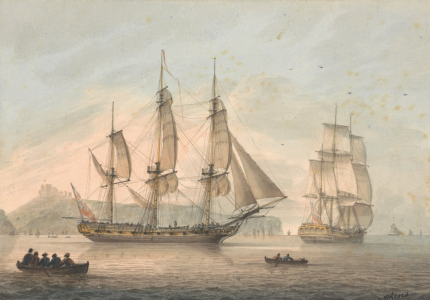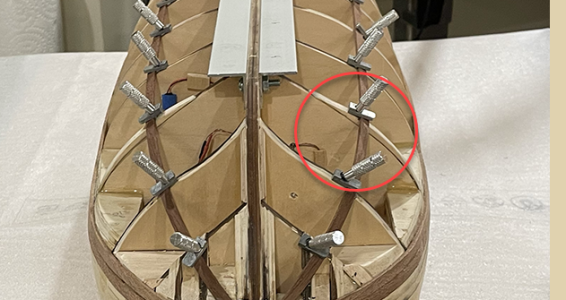The kit mentions 1750, but I haven't done any research on the matter. A.L. included the long boat, so I'm building it. I'm not certain that I will have it placed above the cockpit, as the kit plan suggests. There are so many "cool details" in the cockpit area that I want to keep visible. I've changed the kit to match the HMS Rose/Surprise that was built in Halifax around 1972 - and that recent ship did not have a long boat. Shrug.FWIW, assuming this is Surprise, 1796 rather than 1774 ....
-

Win a Free Custom Engraved Brass Coin!!!
As a way to introduce our brass coins to the community, we will raffle off a free coin during the month of August. Follow link ABOVE for instructions for entering.
You are using an out of date browser. It may not display this or other websites correctly.
You should upgrade or use an alternative browser.
You should upgrade or use an alternative browser.
H.M.S. Surprise by Artesania Latina - Build log
- Thread starter RegW
- Start date
- Watchers 28
-
- Tags
- artesania latina surprise
LOL I'm hardly an expert on this (or any other for that matter) topic. However, of the Anatomy of the Ship books that show boats on the deck, most of them are upright. I would imagine that they would cover them with canvas to keep the water out.Hi Jeff! Quick question for your knowledge of such things : were these longboats secured to the deck inverted, or upright? I figured they would be inverted to avoid filling with rain and/or sea water. But the plans call for it to be upright - which means the interior details of the longboat would be visible. Your thoughts?
- Joined
- Dec 17, 2024
- Messages
- 53
- Points
- 88

And so they would have been stacked on the waist beams?- it’s wide enough for two. This may be meat for a new thread, I scanned the ships boats from Laverry & Hunts “The Frigate Surprise” pg. 70-71 and attempted to make 1:48 laser cutting files for ribs of each (26’ launch, 24’ 6” cutter, 25’ pinnace, 18’ jolly boat, and 17’ skiff). I think the one A.L. included boat is closest to the cutter in dimensions.
Happy to share files, they need improvement! (tiff scans placed in Illustrator).
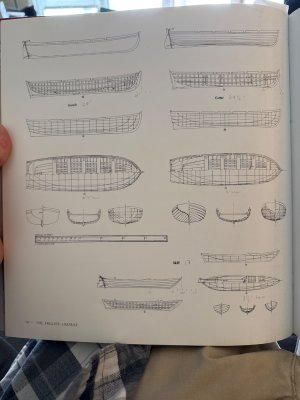
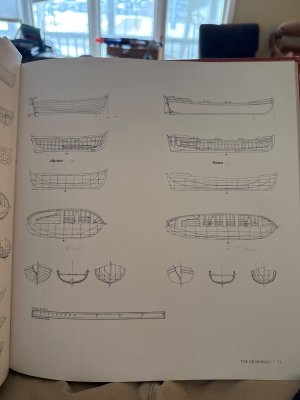
Happy to share files, they need improvement! (tiff scans placed in Illustrator).


To answer your original question of stowing the boats, I never realized what a mystery this is until spending the last two hours researching for my own satisfaction. For English ships' boats, up until about 1625 boats were towed using a heavy boat rope and a lighter gust rope. Even afterwards, according to Mainwaring, long boats were not hoisted in. His comment was "a good longboat will live in any grown sea if the water be sometimes freed, unless the sea break very much." They were of course still vulnerable to heavy seas, strong winds and battle. Things changed and some sort of stowage in the waist started about that time. At least one boat could be carried in the waist. When the long boats or pinnaces were resting on the gallows, there was only room for one boat unless nested with one in the other which was not done until later in the 19th century when all the thwarts were easily removed. But, in the 18th century some of the thwarts were fixed with knees so could not be removed to nest the boats. When resting on spars that went for the FC to the QD there was room for more than one boat side by side. The Van de Velde the Elder drawing of Neptune 1683 (see below) shows an upright boat as does one model from the 18th century with a pinnace resting on spare spars that Lavery shows on page 234 of The Arming and Fitting of English Ships of War In summary Lavery wrote that for some periods "it is a mystery how others were stored" If he couldn't figure it out completely, it appears there may be no set method and I will not feel guilty if I get ever get it wrong.
Cheers
Allan
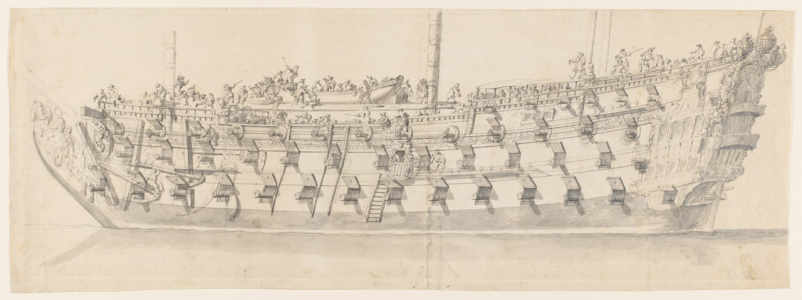
Cheers
Allan

If you are interested, there are scantlings for the floors and futtocks (ribs) to be sure they have the correct siding and moulded dimensions for each boat you mention in post #120 above.attempted to make 1:48 laser cutting files for ribs of each
Allan
Nice drawings, and thank you for including them here. I'm not ready to try "scratch building" boats or ships so I don't need the scans. But thank you!And so they would have been stacked on the waist beams...
The Master Korabel boat kits are absolutely fantastic. I understand hesitance of tackling a small boat from scratch. The parts are tiny and very delicate. The Falkonet boat models are equally good, but are not available these days. Hopefully the situation in Russia and Ukraine will get better and Falkonet will be shipping their products again soon. The boat below was made from a Falkonet kit.Nice drawings, and thank you for including them here. I'm not ready to try "scratch building" boats or ships so I don't need the scans. But thank you!
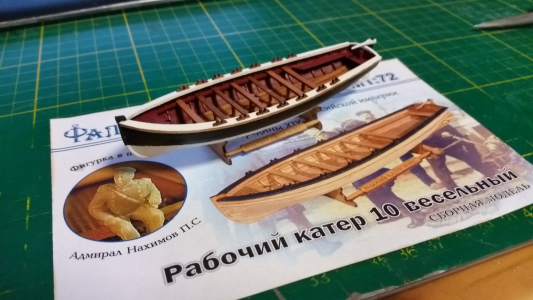
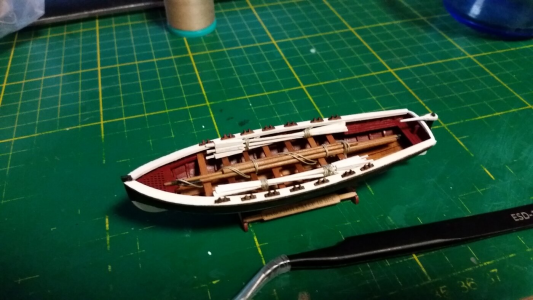
Last edited:
This will be my last work on the longboat for this weekend. Have a work call at 5am tomorrow morning. Ack! So I essentially completed the assembly of the boat, but still have some varnishing to do, along with the rudder installation after the varnish is dry. The kit did not provide pre-formed hinges for the boat, so I got some practice making those. Expert purists will gag when they see the knob I placed on the end of the tiller lever. LOL!
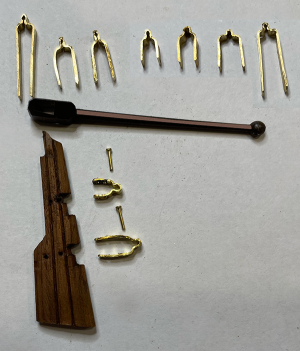

Good morning Reg. This is a true storyExpert purists will gag when they see the knob I placed on the end of the tiller lever. LOL!
 . Some of us strive for 100%replicas, some of us strive to have fun and build a cool model. You owned that ships boat. Funny thing is I always leave my boats so that when I get sick of rigging I still have something to build
. Some of us strive for 100%replicas, some of us strive to have fun and build a cool model. You owned that ships boat. Funny thing is I always leave my boats so that when I get sick of rigging I still have something to buildJust catching up on your latest developments. Looking good.
Hi Reg.The kit mentions 1750,
Most folks just want to build which is what a hobby is about which is a great thing. But, the kit mentioning 1750 made me curious.
Allan
Hello Dan,Your work is amazing.
I noted what appeared to be filler on the ribs (see screenshot). Did you have to add some to the ribs?
Yes, I added those two filler pieces of linden on the 3rd rib. When I "dry fitted" the planks, there was a significant gap there that didn't look correct if the planks were attached without the filler. I could have sanded down rib 4 I suppose.
Very good. Your ship looks beautiful. You've done some good work on it.Hello Dan,
Yes, I added those two filler pieces of linden on the 3rd rib. When I "dry fitted" the planks, there was a significant gap there that didn't look correct if the planks were attached without the filler. I could have sanded down rib 4 I suppose.
- Joined
- Mar 1, 2022
- Messages
- 655
- Points
- 308

Great job on that sternManaged to complete the stern details that I added to the project. None of these parts are included in the kit.
View attachment 438063
I haven't glued these details in place as I still need to determine their final colour.
View attachment 438064
The next step is to install the gun deck canons. 12 of these will be visible and
require proper rigging. The plan that A.L. provided has some flaws regarding
this...
From the instruction manual:
View attachment 438065
My modification (built a jig from scrap that was kicking around):
View attachment 438066
View attachment 438067
Now I'll ask for suggestions on the best method of "treating" the ropes so that they
hold their position and simulate "gravity" effects. I've tried diluted carpenters glue,
but I'm open to any better solutions
You can buy their kits even now. The only problem will be the shipping cost, since the only option is individual parcel by regular mail.Hopefully the situation in Russia and Ukraine will get better and Falkonet will be shipping their products again soon.
Re-worked the longboat hinges. Soldering these is far easier than bending the brass strips to accomodate the hinge pin. I used 1.2mm OD brass tube with an ID of 0.7mm. The hinge pin slides in as easy as the hinge pins on my house doors.


After blackening the solder joints:
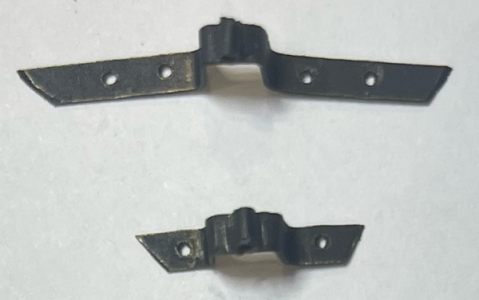
The longboat is completed aside from the masts - which will be added after I "dust-off" my lathe.

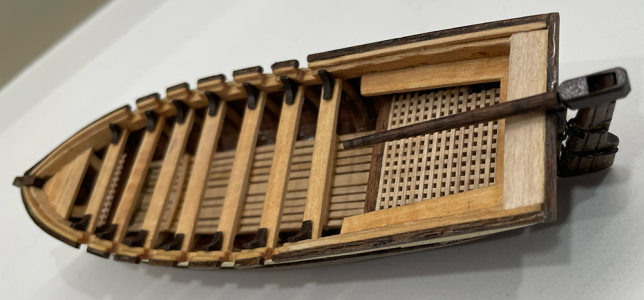


After blackening the solder joints:

The longboat is completed aside from the masts - which will be added after I "dust-off" my lathe.


Last edited:
Just commenced the first part of the mast rigging. I assembled the tops earlier, but forgot to add the screen at the rails. Forgot? Or procrastinated? The screens were a pain... but I got them done (if not perfect).
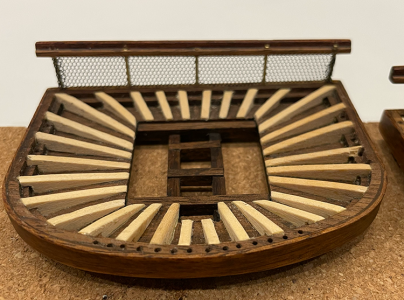
Now working on my block rigging technique. I experimented with line splicing these blocks but need to improve that skill before I take-on small diameter rope.
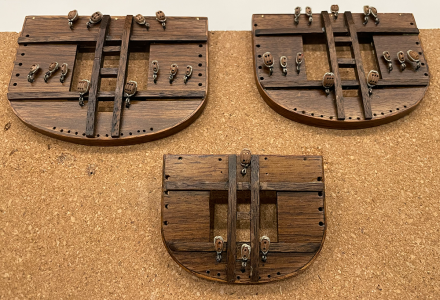

Now working on my block rigging technique. I experimented with line splicing these blocks but need to improve that skill before I take-on small diameter rope.

The closure with netting looks really good and so nice that you included it. From James Lees The Masting and Rigging of English Ships of War page 23 to compare with Artesania Latina's concept of tops. Note that the holes for crow's feet extend nearly to the outboard sides which you can add if you want to.
Allan

Allan






